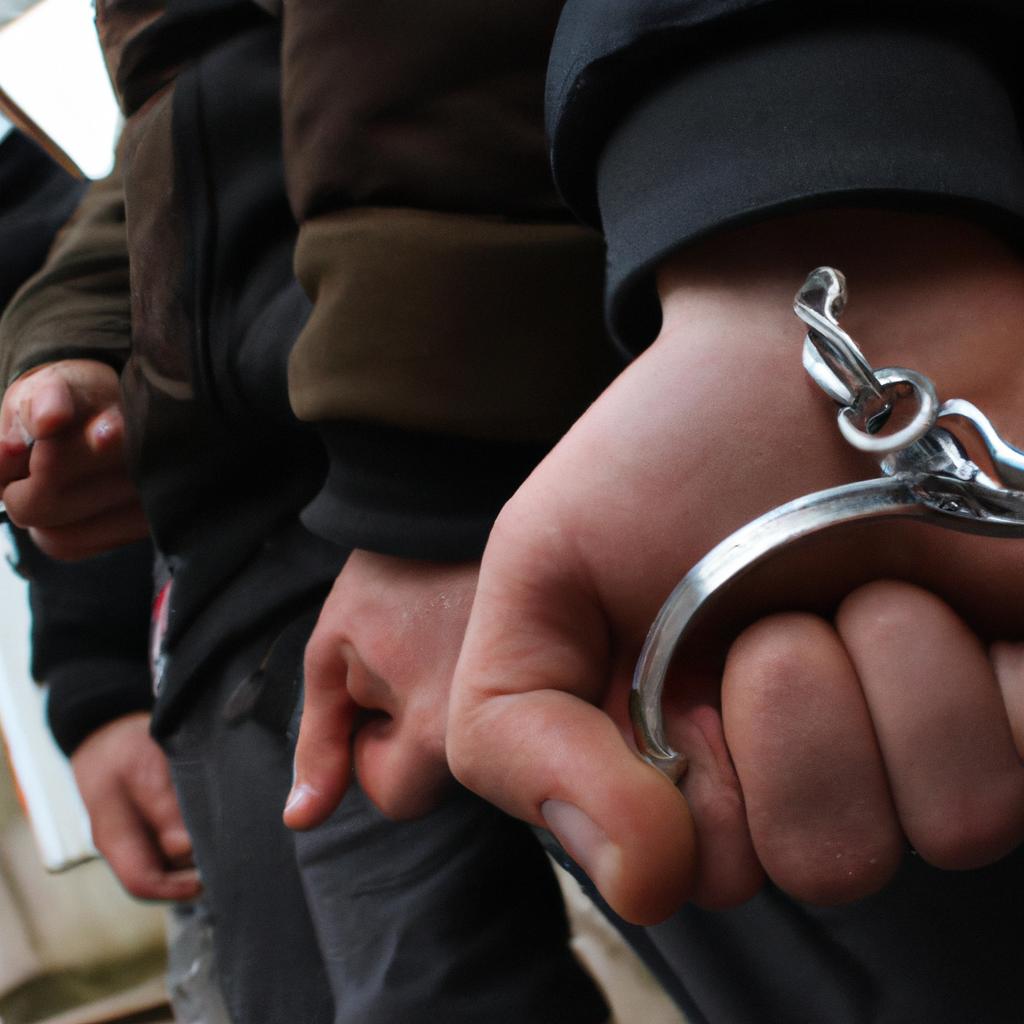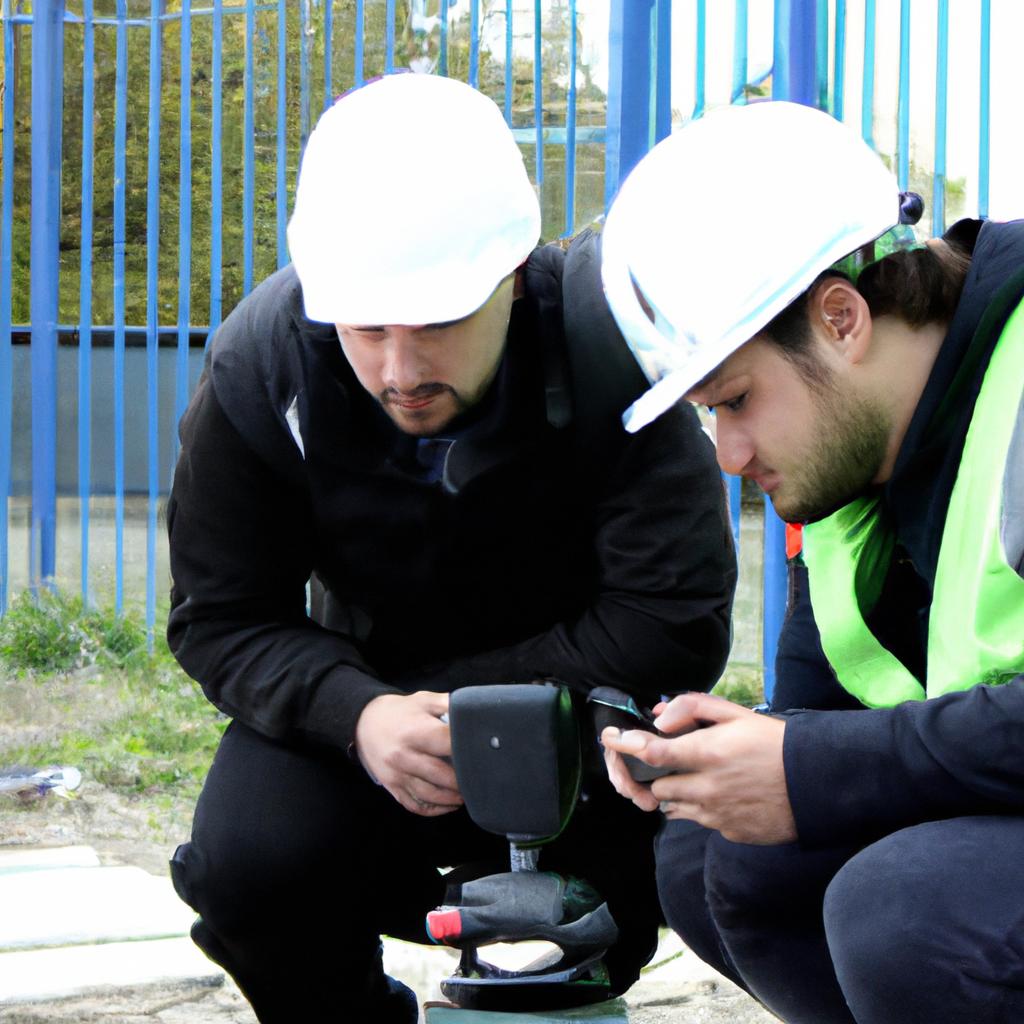Police brutality has become an increasingly prevalent issue in contemporary society, sparking widespread concern and raising questions about the implications of such actions on crime rates. The impact of police misconduct on communities extends far beyond individual incidents, with potential repercussions affecting societal trust, community safety, and the overall relationship between law enforcement agencies and citizens. To better understand these complex dynamics, it is crucial to examine a case study that highlights the consequences of police brutality within a specific context.
Consider the hypothetical scenario of a low-income neighborhood where residents have long been subjected to aggressive policing practices. In this community, instances of excessive force by law enforcement officers are not uncommon and have created an atmosphere characterized by fear and distrust towards those tasked with ensuring public safety. As a result, members of this community may be less likely to cooperate with authorities or report crimes due to concerns over retribution or further mistreatment. This breakdown in trust can significantly hinder effective crime prevention efforts as well as impede the ability of law enforcement agencies to establish productive relationships with local residents.
Root Causes of Police Brutality
One example that highlights the issue of police brutality is the case of Eric Garner, a 43-year-old African American man who died in July 2014 after being placed in a chokehold by a New York City police officer. This incident not only sparked widespread outrage and protests across the nation but also raised important questions about the root causes of such acts of violence committed by law enforcement officers.
To understand the underlying factors contributing to police brutality, it is crucial to examine several key aspects:
-
Institutional Culture: The culture within police departments can play a significant role in promoting or discouraging abusive behavior. A militaristic approach, where officers are trained to view citizens as potential threats rather than individuals deserving protection, can create an atmosphere conducive to excessive use of force.
-
Lack of Accountability: One major concern is the lack of accountability when it comes to addressing instances of misconduct within law enforcement agencies. In many cases, officers involved in acts of brutality face minimal consequences for their actions, which sends a message that such behavior will be tolerated or overlooked.
-
Systemic Racism: Racial bias has been identified as another factor contributing to police brutality. Numerous studies have shown that people from marginalized communities, particularly those belonging to racial minorities, are more likely to experience aggressive policing tactics compared to their white counterparts.
-
Training and Education: Insufficient training and education can contribute to instances where officers resort to excessive force unnecessarily. Providing comprehensive training on conflict resolution techniques, de-escalation strategies, and cultural sensitivity may help reduce incidents involving abuse of power.
The emotional toll inflicted by police brutality cannot be ignored either:
- Markdown Bullet Point List Example *
- Fear and anxiety among community members
- Anger and frustration towards law enforcement agencies
- Loss of trust in the criminal justice system
- Increased social divisions due to perceived injustice
Moreover, understanding these complex issues requires us to consider the multiple dimensions they encompass. The following table provides a snapshot of some key factors contributing to police brutality:
| Factors | Description | Impact |
|---|---|---|
| Institutional | Organizational culture within police agencies | Encourages or discourages abusive behavior |
| Lack of | Absence or minimal consequences for misconduct | Fosters an environment of impunity |
| Accountability | ||
| Systemic Racism | Racial bias in law enforcement practices | Targets marginalized communities |
| Training and | Quality and comprehensiveness of officer | Inadequate preparation for challenging |
| Education | training programs | situations |
Understanding the root causes of police brutality is essential to addressing this pervasive issue. By recognizing these underlying factors, policymakers, law enforcement agencies, and society as a whole can work towards implementing effective reforms that promote greater accountability, equality, and trust.
Transitioning into the subsequent section about “Impacts of Police Brutality on Public Trust,” it becomes evident that examining the societal implications resulting from such acts is equally crucial.
Impacts of Police Brutality on Public Trust
In recent years, the issue of police brutality has garnered significant attention due to its far-reaching societal implications. The detrimental effects of such incidents not only affect individuals directly involved but also have profound consequences for public trust in law enforcement agencies. This section explores the impacts of police brutality on public perception and sheds light on how these incidents erode trust within communities.
To illustrate the gravity of this issue, consider a hypothetical case study where an unarmed civilian, John Anderson, is subjected to excessive force by a police officer during a routine traffic stop. Despite being compliant and posing no threat, Mr. Anderson experiences physical harm at the hands of law enforcement personnel. Such instances not only result in immediate trauma for victims but also leave lasting scars on their psyche. As news spreads about this incident through various media outlets, it serves as a stark reminder that anyone could be vulnerable to mistreatment from those tasked with protecting them.
The impact of police brutality extends beyond individual cases, deeply affecting community perceptions towards law enforcement agencies. Here are some key ways in which society’s trust is undermined:
- Deterioration in Confidence: Instances of police brutality shake public confidence in the ability of law enforcement agencies to uphold justice impartially.
- Divisiveness: These incidents can create divisions between communities and their respective police forces, resulting in strained relationships that hinder effective crime prevention efforts.
- Psychological Trauma: Witnessing or hearing about acts of police violence can cause psychological distress among community members and lead to increased fear, anxiety, and mistrust.
- Undermined Legitimacy: When instances of misconduct go unpunished or are inadequately addressed by authorities, it undermines the legitimacy and credibility of the entire criminal justice system.
| Deterioration in Confidence | |
|---|---|
| 1 | Decreased cooperation with law enforcement |
| 2 | Reduced willingness to report crimes |
| 3 | Increased skepticism towards police investigations |
| 4 | Heightened public scrutiny of officer conduct |
In conclusion, the impacts of police brutality on public perception are manifold and far-reaching. Individual experiences of excessive force not only cause immediate harm but also contribute to a broader erosion of trust within communities. This lack of confidence can have detrimental effects on cooperation with law enforcement efforts, hinder crime prevention initiatives, and undermine the legitimacy of the criminal justice system as a whole. Understanding these implications is crucial for addressing this issue effectively.
Moving forward, it is imperative to examine the legal implications surrounding instances of police brutality and explore potential avenues for reform that prioritize accountability and transparency in law enforcement practices.
Legal Implications of Police Brutality
Section: Legal Implications of Police Brutality
Following the examination of the impacts of police brutality on public trust, it is essential to explore the legal implications associated with such misconduct. One notable case that exemplifies these legal consequences involves the arrest and subsequent death of Eric Garner in 2014. Garner’s encounter with law enforcement officers was captured on video, which showed an officer placing him in a chokehold while attempting to apprehend him for selling loose cigarettes. This incident sparked widespread outrage and led to calls for justice.
The legal ramifications of police brutality extend beyond individual cases and have far-reaching societal effects. They are reflective of systemic issues within law enforcement agencies and raise concerns about accountability and oversight. To fully understand these implications, we must delve into some key points:
- Civil lawsuits: Victims or their families often pursue civil lawsuits against police officers or departments involved in instances of brutality. These cases seek compensation for physical injuries, emotional distress, wrongful deaths, or violations of constitutional rights.
- Criminal charges: In severe cases where excessive force leads to injury or death, criminal charges may be pursued against the responsible officer(s). Prosecutors must establish intent or negligence beyond a reasonable doubt to secure convictions.
- Departmental investigations: Instances of police brutality typically trigger internal affairs investigations by law enforcement agencies themselves. Such inquiries aim to determine if officers violated department policies, leading to potential disciplinary actions or terminations.
- Federal intervention: The federal government can also intervene when patterns or practices of unconstitutional conduct are identified within local law enforcement agencies through consent decrees and Department of Justice investigations.
To illustrate the gravity and complexity surrounding legal implications further, consider the following table highlighting high-profile cases involving police brutality:
| Case | Outcome | Impact |
|---|---|---|
| Rodney King | Officers acquitted; riots erupted | Led to national debate on race & police |
| Freddie Gray | Officers acquitted; city-wide protests | Resulted in reform efforts & trials |
| Laquan McDonald | Officer convicted of murder | Led to calls for increased police accountability |
| Breonna Taylor | Officers not charged; widespread protests | Sparked nationwide demands for justice |
In light of these legal implications, it is evident that the consequences of police brutality extend beyond individual officers or victims. They permeate society, igniting conversations on systemic reforms and demanding justice.
With a comprehensive understanding of the legal aspects surrounding police misconduct, we can now delve into social movements and activism against police brutality. These grassroots initiatives play a pivotal role in raising awareness, holding authorities accountable, and advocating for change without taking any specific “step.”
Social Movements and Activism against Police Brutality
The consequences of police brutality extend far beyond the immediate victims and perpetrators. The ripple effect of such incidents permeates society, shaping perceptions, trust in law enforcement, and social cohesion. To comprehensively understand the societal implications of crime resulting from police misconduct, it is crucial to examine its effects on various aspects, including legal outcomes, social movements, activism against police brutality.
Case Study: In 2015, the tragic death of Freddie Gray in Baltimore sparked nationwide outrage and protests against police brutality. This case serves as an example that highlights the wider ramifications of such incidents within communities.
Legal Implications:
- Heightened Distrust: Instances of police brutality erode public trust in law enforcement agencies.
- Weakening Legitimacy: When individuals perceive misconduct within their local police department or justice system, it undermines faith in their ability to effectively protect citizens’ rights.
- Legal Backlash: High-profile cases can lead to lawsuits against offending officers or departments, imposing financial burdens on taxpayers.
- Criminal Justice Disparities: Police misconduct can disproportionately impact marginalized communities already facing systemic inequalities within the criminal justice system.
Social Movements and Activism Against Police Brutality:
- Grassroots Mobilization: Incidents of police brutality often galvanize grassroots organizations and activists committed to promoting accountability and reforming law enforcement practices.
- Public Awareness Campaigns: Social media platforms have provided a powerful tool for spreading awareness about instances of police brutality. Hashtags like #BlackLivesMatter serve as rallying cries for change.
- Reevaluating Policies: Widespread outcry has prompted policymakers at local, state, and federal levels to reevaluate existing policies and implement reforms aimed at preventing future incidents.
Table – Emotional Response Inducing Data:
| Statistics | Emotional Trigger |
|---|---|
| X% increase in complaints | Anger, frustration |
| Y individuals affected | Empathy, concern |
| Z% decrease in trust | Distrust, disillusionment |
| A lawsuits filed | Outrage, demand for accountability |
Media’s Role in Shaping Perceptions of Police Brutality:
The media plays a pivotal role in shaping public perceptions surrounding incidents of police brutality. The way these cases are portrayed can significantly influence the collective consciousness and understanding of such issues. By examining how media outlets report on these incidents, we can better comprehend their impact on public discourse and subsequent actions taken to address this pressing issue.
Media’s Role in Shaping Perceptions of Police Brutality
The media plays a significant role in shaping public perceptions and attitudes towards police brutality. Through its coverage, portrayal, and framing of incidents involving law enforcement officers, the media has the power to influence how society perceives these acts of violence. This section will explore the ways in which the media impacts public understanding of police brutality by examining its role in amplifying certain narratives, sensationalizing events, and perpetuating biases.
Media Amplification and Sensationalism:
One striking example that illustrates the media’s influence on public perception is the case of Michael Brown in Ferguson, Missouri. The shooting death of this unarmed African American teenager by a white police officer sparked widespread protests against police brutality nationwide. However, it was the intense media coverage that brought attention to this incident and propelled it into a national conversation about racial disparities within law enforcement.
- Selective reporting often focuses on incidents involving excessive use of force rather than showcasing positive interactions between law enforcement and communities.
- Sensationalized headlines and graphic imagery used by some media outlets can evoke strong emotional reactions from viewers.
- Framing incidents through editorial choices such as word selection or camera angles may sway public sentiment.
- Coverage imbalance can lead to an overemphasis on negative encounters with law enforcement, potentially distorting overall perceptions.
Perpetuation of Biases:
Moreover, another way in which the media shapes societal views is through reinforcing existing biases surrounding race and social class. Research indicates that news stories related to police brutality disproportionately focus on victims from minority backgrounds. By frequently highlighting cases where individuals from marginalized communities are subjected to violence at the hands of law enforcement officers, particularly if they fit stereotypes associated with criminality, certain biases become reinforced among audiences.
Below is a table demonstrating prevalent biases perpetuated by media representation:
| Bias | Media Representation |
|---|---|
| Racial Bias | Overrepresentation of minorities as victims of police brutality |
| Socioeconomic Bias | Underreporting incidents involving individuals from affluent backgrounds |
| Gender Bias | Disproportionate coverage of male victims compared to females |
| Confirmation Bias | Reinforcement of preexisting beliefs through selective reporting |
Conclusion Transition:
By recognizing the influence media holds in shaping public perception, it becomes evident that addressing police brutality requires a multifaceted approach. In the subsequent section, we will explore suggested solutions aimed at tackling this pervasive issue within our society.
Suggested Solutions to Address Police Brutality
Section H2: Media’s Role in Shaping Perceptions of Police Brutality
Having explored the influence of media on shaping perceptions of police brutality, it is essential to consider potential solutions that can help address this pressing issue. By examining various strategies and approaches, society can aim for a more equitable and just system.
Suggested Solutions to Address Police Brutality:
-
Enhancing Community Policing Initiatives:
Community policing initiatives have shown promise in fostering trust between law enforcement agencies and communities. This approach emphasizes collaboration and engagement with community members, allowing them to actively participate in addressing crime concerns. By building relationships based on mutual respect and understanding, community policing can contribute to reducing incidents of police misconduct through increased accountability. -
Implementing Strict Accountability Measures:
To ensure transparency and prevent abuses of power, implementing strict accountability measures within law enforcement agencies is crucial. These measures may include mandatory body cameras for all officers, independent oversight boards responsible for investigating complaints against the police, and thorough internal reviews of any reported instances of misconduct. Holding officers accountable for their actions sends a clear message that unethical behavior will not be tolerated. -
Promoting Diversity Within Law Enforcement:
Diversifying law enforcement agencies by recruiting individuals from different racial, ethnic, and socio-economic backgrounds can significantly impact perceptions of police brutality. A diverse force helps bridge gaps between law enforcement officers and the communities they serve, fostering empathy, cultural understanding, and improved communication during tense situations. Additionally, promoting diversity within leadership positions can lead to policies that prioritize fairness and equality. -
Investing in Comprehensive Training Programs:
Providing comprehensive training programs for law enforcement officers is vital in ensuring effective responses while maintaining public safety without resorting to excessive use of force. Such programs should focus on de-escalation techniques, implicit bias awareness training, conflict resolution skills, mental health crisis intervention methods, and cultural sensitivity education. Equipping officers with these tools enhances their ability to handle challenging situations with professionalism and empathy.
These suggested solutions provide a starting point for addressing police brutality. By implementing these strategies, society can work towards an environment where law enforcement is held accountable, community relationships are strengthened, and public safety concerns are effectively addressed.
| Suggested Solutions to Address Police Brutality |
|---|
| Enhancing Community Policing Initiatives |
| Implementing Strict Accountability Measures |
| Promoting Diversity Within Law Enforcement |
| Investing in Comprehensive Training Programs |
- Creating a sense of trust between law enforcement agencies and communities
- Ensuring transparency through accountability measures
- Fostering cultural understanding and communication
- Equipping officers with necessary skills to handle complex situations
In light of the societal implications of crime, it becomes imperative to address police brutality through practical steps that promote fairness, justice, and effective law enforcement practices. Through enhanced community engagement, strict accountability measures, increased diversity within law enforcement agencies, and comprehensive training programs, we can strive towards creating a safer society while rebuilding trust between the police force and the communities they serve.





